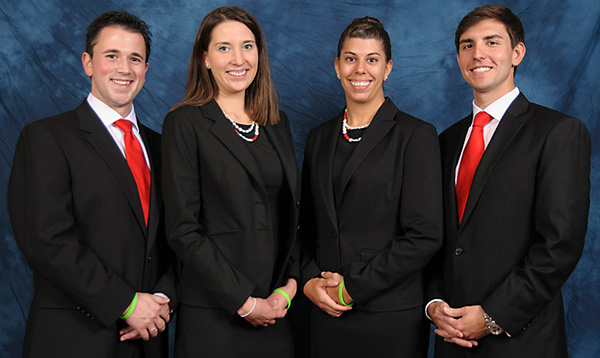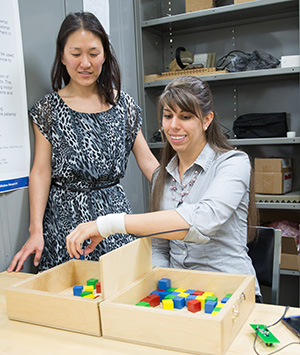
A diminished ability to pinch leaves many stroke patients at a loss to accomplish even small tasks, like buttoning a shirt or brushing their teeth.
As a UWM doctoral student, Leah Enders noticed that the finger grip of these patients was worse if they also experienced numbness. In search of treatment that would address both problems, Enders and Na Jin Seo, assistant professor of industrial and manufacturing engineering, used “sub-threshold,” or unfelt, vibrations.
“We found that putting these vibrations at the wrist increased the cortical activation throughout the hand,” says Enders. The prototype wristband they developed does just that – it enhances touch sensation and general motor skills in the hands.

The improvements these vibrations provide are a well-known phenomenon, but how they work and whether they work if placed away from the afflicted part of the body is still not understood.
Now the two are building on the research, investigating the connection between the vibrations and neural communication as the mechanism for sensory improvement.
“The TheraBracelet allows anyone with a loss of fine motor skills to go about their daily routines and maintain independence,” she says.
Early success
Seo immediately recognized that the prototype device’s results held commercial potential.
She received one of only a few UW System Applied Research Grants last year to continue prototype development of the TheraBracelet with collaborator John Webster, a professor emeritus at UW-Madison.
After Seo and Enders took out a provisional patent on the technology through the UWM Research Foundation, it quickly attracted the attention of graduate business students from the University of Louisville. They approached Seo about collaborating to develop the bracelet into a product.
The Louisville collaborators, along with Enders, have formed a startup company, TheraBracelet LLC, and submitted an application to the FDA for regulatory clearance. Approval is expected in early fall, after which it can be sold as a medical device.
In February, the group of students, now all graduated, took first place in one of the country’s oldest intercollegiate competitions for entrepreneurs: the Georgia Bowl Business Plan Competition at Kennesaw State University near Atlanta.
The group will target the “stroke belt” – 11 southeastern states with an unusually high incidences of stroke and other forms of cardiovascular disease.
They followed that with a pitch of the product at the Rice Business Plan Competition, garnering the interest of an investor.
The ‘stroke belt’ a target
The market for electro-stimulation devices is estimated at $16 million, says Matthew Raggard, TheraBracelet’s CEO.
The group will target physical therapists and large rehabilitation clinics in the “stroke belt” – 11 southeastern states recognized by public health authorities for having an unusually high incidence of stroke and other forms of cardiovascular disease, says Raggard.
While the startup company’s team works to bring the product to the marketplace, research continues into exactly how the sub-threshold vibrations used in the TheraBracelet work.
Seo and collaborator Brian Schmit at Marquette University are using an electroencephalogram (EEG) to measure the brain activity of patients wearing the device. A similar brain monitoring study is being conducted by Seo and Wendy Huddleston, UWM assistant professor of kinesiology, using functional magnetic resonance imaging (fMRI).
After the final prototype is completed in early fall, the new company’s members plan to work directly with physical therapists to continue clinical trials.
“I am most excited about seeing how this technology could be used to improve gripping not just with stroke patients,” says Enders, “but other populations such as the elderly, as well.”







